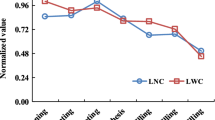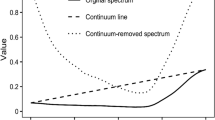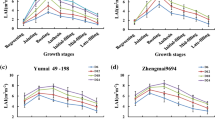Abstract
Potassium (K) is one of three main crop nutrients, and the high rate of potash fertilizer utilization (second only to nitrogen) leads to high prices. Therefore, efficient application, as well as rapid and time monitoring of K in crops is essential. Several turnover box and field experiments were conducted across multiple years and cultivation factors (i.e., potassium levels and plant varieties) yielding 340 groups of leaf samples with different K contents; these samples were used to examine the relationship between reflectance spectra (350–2500 nm) and leaf K content (LKC). The correlation between LKC and the two-band spectral indices computed with random two bands from 350 to 2500 nm were determined for the published K vegetation indices in rice. Results showed that the spectral reflectance, R, of the shortwave infrared (1300–2000 nm) region was sensitive to the K levels and significantly correlated with rice LKC. New shortwave infrared two-band spectral indices, Normalized difference spectral index [NDSI (R1705, R1385)], Ratio spectral index [RSI (R1385, R1705)], and Difference spectral index [DSI (R1705, R1385)], showed good correlations with LKC (R2 up to 0.68). Moreover, the three-band spectral indices (R1705 − R700)/(R1385 − R700) and (R1705 − R1385)/(R1705 + R1385 − 2 × R704) were developed by adding red edge bands to improve accuracy. Three-band spectral indices had an improved prediction accuracy for rice LKC (R2 up to 0.74). However, several previously published K-sensitive vegetation indices did not yield good results in this study. Validation with independent samples showed that the indices (R1705 − R700)/(R1385 − R700) and (R1705 − R1385)/(R1705 + R1385 − 2 × R704) had higher accuracies and stabilities than two-band indices and are suitable for quantitatively estimating rice LKC. The widescale application of these proposed vegetation indices in this paper still needs to be verified in different environmental conditions. This study provides a technical basis for LKC monitoring using spectral remote sensing in rice.







Similar content being viewed by others
References
Ahmad, I., & Maathuis, F. J. (2014). Cellular and tissue distribution of potassium: Physiological relevance, mechanisms and regulation. Journal of Plant Physiology,171(9), 708–714. https://doi.org/10.1016/j.jplph.2013.10.016.
Alabbas, A. H., Barr, R., Hall, J. D., Crane, F. L., & Baumgardner, M. F. (1974). Spectra of normal and nutrient-deficient maize leaves. Agronomy Journal,66, 16–20. https://doi.org/10.2134/agronj1974.00021962006600010005x.
Albayrak, S. (2008). Use of reflectance measurements for the detection of N, P, K, ADF and NDF contents in sainfoin pasture. Sensors,8(11), 7275–7286. https://doi.org/10.3390/s8117275.
Ata-Ul-Karim, S. T., Cao, Q., Zhu, Y., Tang, L., Rehmani, M. I., & Cao, W. X. (2016a). Non-destructive assessment of plant nitrogen parameters using leaf chlorophyll measurements in rice. Frontiers in Plant Science,7(e104540), 1829. https://doi.org/10.3389/fpls.2016.01829.
Ata-Ul-Karim, S. T., Liu, X. J., Lu, Z. Z., Yuan, Z. F., Zhu, Y., & Cao, W. X. (2016b). In-season estimation of rice grain yield using critical nitrogen dilution curve. Field Crops Research,195, 1–8. https://doi.org/10.1016/j.fcr.2016.04.027.
Ayala-Silva, T., & Beyl, C. A. (2005). Changes in spectral reflectance of wheat leaves in response to specific macronutrient deficiency. Advances in Space Research,35(2), 305–317. https://doi.org/10.1016/j.asr.2004.09.008.
Birth, G. S., & Mcvey, G. R. (1968). Measuring the color of growing turf with a reflectance spectrophotometer. Agronomy Journal,60(6), 640–643. https://doi.org/10.2134/agronj1968.00021962006000060016x.
Chappell, A., Webb, N. P., Guerschman, J. P., Thomas, D. T., Mata, G., Handcock, R. N., et al. (2018). Improving ground cover monitoring for wind erosion assessment using MODIS BRDF parameters. Remote Sensing of Environment,204, 756–768. https://doi.org/10.1016/j.rse.2017.09.026.
Chen, S., Li, D., Wang, Y., Peng, Z., & Chen, W. (2011). Spectral characterization and prediction of nutrient content in winter leaves of litchi during flower bud differentiation in southern china. Precision Agriculture,12(5), 682–698. https://doi.org/10.1007/s11119-010-9213-2.
Chen, L., Lin, L., Cai, G., Sun, Y., Huang, T., Wang, K., et al. (2014). Identification of nitrogen, phosphorus, and potassium deficiencies in rice based on static scanning technology and hierarchical identification method. PLoS ONE,9(11), e113200. https://doi.org/10.1371/journal.pone.0113200.
Curran, P. J. (1989). Remote sensing of foliar chemistry. Remote Sensing of Environment,30(3), 271–278. https://doi.org/10.1016/0034-4257(89)90069-2.
Das, P. K., Choudhary, K. K., Laxman, B., Rao, S. V. C. K., & Seshasai, M. V. R. (2014). A modified linear extrapolation approach towards red edge position detection and stress monitoring of wheat crop using hyperspectral data. International Journal of Remote Sensing,35(4), 1432–1449. https://doi.org/10.1080/01431161.2013.877616.
Elvidge, C., & Lyon, R. P. (1985). Estimation of the vegetation contribution to the 1.65/2.22 μm ratio in airborne thematic-mapper imagery of the virginia range, nevada. International Journal of Remote Sensing,6(1), 75–88. https://doi.org/10.1080/01431168508948425.
Feng, W., Guo, B. B., Zhang, H. Y., He, L., Zhang, Y. S., Wang, Y. H., et al. (2015). Remote estimation of above ground nitrogen uptake during vegetative growth in winter wheat using hyperspectral red-edge ratio data. Field Crops Research,180, 197–206. https://doi.org/10.1016/j.fcr.2015.05.020.
Feret, J. B., François, C., Asner, G. P., Gitelson, A. A., Martin, R. E., Bidel, L. P. R., et al. (2008). PROSPECT-4 and 5: Advances in the leaf optical properties model separating photosynthetic pigments. Remote Sensing of Environment,112(6), 3030–3043. https://doi.org/10.1016/j.rse.2008.02.012.
Fridgen, J. L., & Varco, J. J. (2004). Dependency of cotton leaf nitrogen, chlorophyll, and reflectance on nitrogen and potassium availability. Agronomy Journal,96(1), 63–69. https://doi.org/10.2134/agronj2004.0063.
Gao, B. C. (1996). NDWI-A normalized difference water index for remote sensing of vegetation liquid water from space. Remote Sensing of Environment,58(3), 257–266. https://doi.org/10.1016/S0034-4257(96)00067-3.
Gao, B. C., & Goetzt, A. F. H. (1995). Retrieval of equivalent water thickness and information related to biochemical components of vegetation canopies from AVIRIS data. Remote Sensing of Environment,52(3), 155–162. https://doi.org/10.1016/0034-4257(95)00039-4.
Gnyp, M. L., Miao, Y. X., Yuan, F., Ustin, S. L., Yu, K., Yao, Y. K., et al. (2014). Hyperspectral canopy sensing of paddy rice aboveground biomass at different growth stages. Field Crops Research,155, 42–55. https://doi.org/10.1016/j.fcr.2013.09.023.
Gómez-Casero, M. T., López-Granados, F., Peña-Barragán, J. M., Jurado-Expósito, M., Torres, L. G., & Fernández-Escobar, R. (2007). Assessing nitrogen and potassium deficiencies in olive orchards through discriminant analysis of hyperspectral data. Journal of the American Society for Horticultural Science,132(5), 611–618.
Inoue, Y., Sakaiya, E., Zhu, Y., & Takahashi, W. (2012). Diagnostic mapping of canopy nitrogen content in rice based on hyperspectral measurements. Remote Sensing of Environment,126, 210–221. https://doi.org/10.1016/j.rse.2012.08.026.
Jackson, R. D., Jones, C. A., Uehara, G., & Santo, L. T. (1981). Remote detection of nutrient and water deficiencies in sugarcane under variable cloudiness. Remote Sensing of Environment,11, 327–331. https://doi.org/10.1016/0034-4257(81)90029-8.
Jacquemoud, S., & Baret, F. (1990). PROSPECT: A model of leaf optical properties spectra. Remote Sensing of Environment,34(2), 75–91. https://doi.org/10.1016/0034-4257(90)90100-Z.
Kawamura, K., Mackay, A. D., Tuohy, M. P., Betteridge, K., Sanches, I. D., & Inoue, Y. (2011). Potential for spectral indices to remotely sense phosphorus and potassium content of legume-based pasture as a means of assessing soil phosphorus and potassium fertility status. International Journal of Remote Sensing,32(1), 103–124. https://doi.org/10.1080/01431160903439908.
Lemaire, G., Francois, C., Soudani, K., Berveiller, D., Pontailler, J., Breda, N., et al. (2008). Calibration and validation of hyperspectral indices for the estimation of broadleaved forest leaf chlorophyll content, leaf mass per area, leaf area index and leaf canopy biomass. Remote Sensing of Environment,112(10), 3846–3864. https://doi.org/10.1016/j.rse.2008.06.005.
Li, D., Cheng, T., Zhou, K., Zheng, H. B., Yao, X., Tian, Y. C., et al. (2017). WREP: A wavelet-based technique for extracting the red edge position from reflectance spectra for estimating leaf and canopy chlorophyll contents of cereal crops. ISPRS Journal of Photogrammetry and Remote Sensing,129, 103–117. https://doi.org/10.1016/j.isprsjprs.2017.04.024.
Li, X. C., Zhang, Y. J., Bao, Y. S., Luo, J. H., Jin, X. L., Xu, X. G., et al. (2014). Exploring the best hyperspectral features for lai estimation using partial least squares regression. Remote Sensing,6(7), 6221–6241. https://doi.org/10.3390/rs6076221.
Mahajan, G. R., Sahoo, R. N., Pandey, R. N., Gupta, V. K., & Kumar, D. (2014). Using hyperspectral remote sensing techniques to monitor nitrogen, phosphorus, sulphur and potassium in wheat (Triticum aestivum, L.). Precision Agriculture,15(5), 499–522. https://doi.org/10.1007/s11119-014-9348-7.
Mutanga, O., & Odindi, J. (2015). Exploring the potential of hyperspectral data and multivariate techniques in discriminating different fertilizer treatments in grasslands. Journal of Applied Remote Sensing,9(1), 096033. https://doi.org/10.1117/1.JRS.9.096033.
Nieves-Cordones, M., Alemán, F., Martínez, V., & Rubio, F. (2014). K+ uptake in plant roots. The systems involved, their regulation and parallels in other organisms. Journal of Plant Physiology,171(9), 688–695. https://doi.org/10.1016/j.jplph.2013.09.021.
Pacumbaba, R. O., & Beyl, C. A. (2011). Changes in hyperspectral reflectance signatures of lettuce leaves in response to macronutrient deficiencies. Advances in Space Research,48(1), 32–42. https://doi.org/10.1016/j.asr.2011.02.020.
Pellissier, P. A., Ollinger, S. V., Lepine, L. C., Palace, M. W., & McDowell, W. H. (2015). Remote sensing of foliar nitrogen in cultivated grasslands of human dominated landscapes. Remote Sensing of Environment,167, 88–97. https://doi.org/10.1016/j.rse.2015.06.009.
Peñuelas, I., Filella, C., Biel, L., & Savé, R. (2007). The reflectance at the 950–970 nm region as an indicator of plant water status. International Journal of Remote Sensing,14(10), 1887–1905. https://doi.org/10.1080/01431169308954010.
Petersen, C. T., Jensen, C. R., & Mogensen, V. O. (2002). Analysis of variation of spectral vegetation index measured in differently fertilized field barley. Communications in Soil Science and Plant Analysis,33, 1485–1506. https://doi.org/10.1081/CSS-120004296.
Pimstein, A., Karnieli, A., Bansal, S. K., & Bonfil, D. J. (2011). Exploring remotely sensed technologies for monitoring wheat potassium and phosphorus using field spectroscopy. Field Crops Research,121(1), 125–135. https://doi.org/10.1016/j.fcr.2010.12.001.
Ponzoni, F. J., De, J. L., & Goncalves, M. (1999). Spectral features associated with nitrogen, phosphorus, and potassium deficiencies in eucalyptus saligna seedling leaves. International Journal of Remote Sensing,20(11), 2249–2264. https://doi.org/10.1080/014311699212236.
Ramoelo, A., Skidmore, A. K., Schlerf, M., Mathieu, R., & Heitkönig, I. M. A. (2011). Water-removed spectra increase the retrieval accuracy when estimating savanna grass nitrogen and phosphorus concentrations. ISPRS Journal of Photogrammetry and Remote Sensing,66(4), 408–417. https://doi.org/10.1016/j.isprsjprs.2011.01.008.
Ren, H., Zhou, G., & Zhang, F. (2018). Using negative soil adjustment factor in soil-adjusted vegetation index (SAVI) for aboveground living biomass estimation in arid grasslands. Remote Sensing of Environment,209, 439–445. https://doi.org/10.1016/j.rse.2018.02.068.
Rock, B. N., Vogelmann, J. E., Williams, D. L., Vogelmann, A. F., & Hoshizaki, T. (1986). Remote detection of forest damage: plant responses to stress may have spectral “signatures” that could be used to map, monitor, and measure forest damage. BioScience,36(7), 439–445. https://doi.org/10.2307/1310339.
Römheld, V., & Kirkby, E. A. (2010). Research on potassium in agriculture: needs and prospects. Plant and Soil,335(1–2), 155–180. https://doi.org/10.1007/s11104-010-0520-1.
Rouse, J. W. J., Haas, R. H., Schell, J. A., & Deering, D. W. (1974). Monitoring vegetation systems in the great plains with ERTS. In: 3rd Earth Resources Technology Satellite-1 Symposium, NASA SP-351, Greenbelt, MD, pp. 301–317. https://ntrs.nasa.gov/search.jsp?R=19740022614.
Schlerf, M., Atzberger, C., Hill, J., Buddenbaum, H., Werner, W., & Schüler, G. (2010). Retrieval of chlorophyll and nitrogen in Norway spruce (Picea abies L. Karst.) using imaging spectroscopy. International Journal of Applied Earth Observation and Geoinformation,12(1), 17–26. https://doi.org/10.1016/j.jag.2009.08.006.
Sims, D. A., & Gamon, J. A. (2002). Relationships between leaf pigment content and spectral reflectance across a wide range of species, leaf structures and developmental stages. Remote Sensing of Environment,81(2–3), 337–354. https://doi.org/10.1016/S0034-4257(02)00010-X.
Singh, V. K., Dwivedi, B. S., Yadvinder, S., Singh, S. K., Mishra, R. P., Shukla, A. K., et al. (2018). Effect of tillage and crop establishment, residue management and K fertilization on yield, K use efficiency and apparent K balance under rice-maize system in north-western India. Field Crops Research,224, 1–12. https://doi.org/10.1016/j.fcr.2018.04.012.
Stadler, A., Rudolph, S., Kupisch, M., Langensiepen, M., Kruk, J. V. D., & Ewert, F. (2015). Quantifying the effects of soil variability on crop growth using apparent soil electrical conductivity measurements. European Journal of Agronomy,64, 8–20. https://doi.org/10.1016/j.eja.2014.12.004.
Tian, Y. C., Yao, X., Yang, J., Cao, W. X., Hannaway, D. B., & Zhu, Y. (2011). Assessing newly developed and published vegetation indices for estimating rice leaf nitrogen concentration with ground- and space-based hyperspectral reflectance. Field Crops Research,121(3), 464. https://doi.org/10.1016/j.fcr.2011.01.009.
Wang, K., Shen, Z. Q., & Wang, R. C. (1999). Vegetation nutrient condition and spectral feature. Remote Sensing of Land Resource,1, 9–14. https://doi.org/10.6046/gtzyyg.1999.01.03. (In Chinese).
Wang, M., Zheng, Q. S., Shen, Q. R., & Guo, S. W. (2013). The critical role of potassium in plant stress response. International Journal of Molecular Sciences,14(4), 7370–7390. https://doi.org/10.3390/ijms14047370.
Yao, X., Huang, Y., Shang, G. Y., Zhou, C., Cheng, T., Tian, Y. C., et al. (2015). Evaluation of six algorithms to monitor wheat leaf nitrogen concentration. Remote Sensing,7(11), 14939–14966. https://doi.org/10.3390/rs71114939.
Yu, K., Lenz-Wiedemann, V., Chen, X., & Bareth, G. (2014). Estimating leaf chlorophyll of barley at different growth stages using spectral indices to reduce soil background and canopy structure effects. ISPRS Journal of Photogrammetry and Remote Sensing,97, 58–77. https://doi.org/10.1016/j.isprsjprs.2014.08.005.
Yuan, Z. F., Ata-Ul-Karim, S. T., Cao, Q., Lu, Z. Z., Cao, W. X., Zhu, Y., et al. (2016). Indicators for diagnosing nitrogen status of rice based on chlorophyll meter readings. Field Crops Research,185, 12–20. https://doi.org/10.1016/j.fcr.2015.10.003.
Zarco-Tejada, P. J., Rueda, C. A., & Ustin, S. L. (2003). Water content estimation in vegetation with MODIS reflectance data and model inversion methods. Remote Sensing of Environment,85(1), 109–124. https://doi.org/10.1016/S0034-4257(02)00197-9.
Zhang, L., Zhou, Z. G., Zhang, G. W., Meng, Y., Chen, B. L., & Wang, Y. H. (2012). Monitoring the leaf water content and specific leaf weight of cotton (Gossypium hirsutum L.) in saline soil using leaf spectral reflectance. European Journal of Agronomy,41, 103–117. https://doi.org/10.1016/j.eja.2012.04.003.
Zörb, C., Senbayram, M., & Peiter, E. (2014). Potassium in agriculture: status and perspectives. Journal of Plant Physiology,171(9), 656–669. https://doi.org/10.1016/j.jplph.2013.08.008.
Acknowledgements
This work was supported by the National Key R&D Program (2018YFD0300805), the Science and Technology Support Program of Jiangsu, China [Grant Numbers BE2016375], the Jiangsu Collaborative Innovation Center for Modern Crop Production, and the Priority Academic Program Development of Jiangsu Higher Education Institutions (PAPD). We would like to thank Dong Li for his help in the data analysis. We are grateful to the reviewers for their suggestions and comments, which significantly improved the quality of this paper.
Author information
Authors and Affiliations
Corresponding author
Additional information
Publisher's Note
Springer Nature remains neutral with regard to jurisdictional claims in published maps and institutional affiliations.
Rights and permissions
About this article
Cite this article
Lu, J., Yang, T., Su, X. et al. Monitoring leaf potassium content using hyperspectral vegetation indices in rice leaves. Precision Agric 21, 324–348 (2020). https://doi.org/10.1007/s11119-019-09670-w
Published:
Issue Date:
DOI: https://doi.org/10.1007/s11119-019-09670-w




